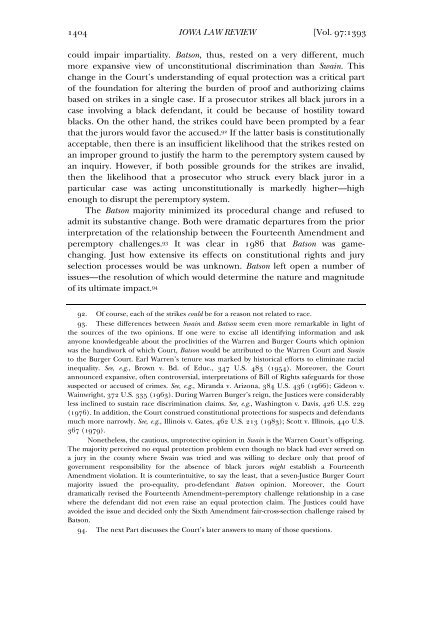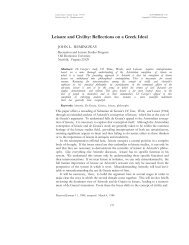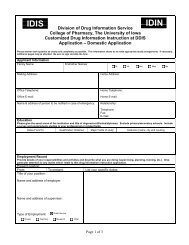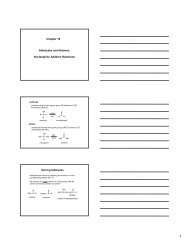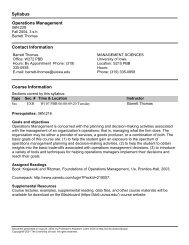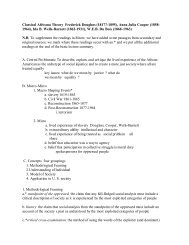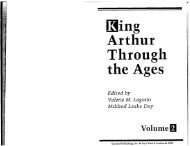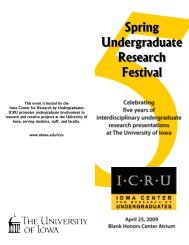Twenty-Five Years of Batson: An Introduction to ... - University of Iowa
Twenty-Five Years of Batson: An Introduction to ... - University of Iowa
Twenty-Five Years of Batson: An Introduction to ... - University of Iowa
You also want an ePaper? Increase the reach of your titles
YUMPU automatically turns print PDFs into web optimized ePapers that Google loves.
1404 IOWA LAW REVIEW [Vol. 97:1393<br />
could impair impartiality. <strong>Batson</strong>, thus, rested on a very different, much<br />
more expansive view <strong>of</strong> unconstitutional discrimination than Swain. This<br />
change in the Court’s understanding <strong>of</strong> equal protection was a critical part<br />
<strong>of</strong> the foundation for altering the burden <strong>of</strong> pro<strong>of</strong> and authorizing claims<br />
based on strikes in a single case. If a prosecu<strong>to</strong>r strikes all black jurors in a<br />
case involving a black defendant, it could be because <strong>of</strong> hostility <strong>to</strong>ward<br />
blacks. On the other hand, the strikes could have been prompted by a fear<br />
that the jurors would favor the accused. 92 If the latter basis is constitutionally<br />
acceptable, then there is an insufficient likelihood that the strikes rested on<br />
an improper ground <strong>to</strong> justify the harm <strong>to</strong> the peremp<strong>to</strong>ry system caused by<br />
an inquiry. However, if both possible grounds for the strikes are invalid,<br />
then the likelihood that a prosecu<strong>to</strong>r who struck every black juror in a<br />
particular case was acting unconstitutionally is markedly higher—high<br />
enough <strong>to</strong> disrupt the peremp<strong>to</strong>ry system.<br />
The <strong>Batson</strong> majority minimized its procedural change and refused <strong>to</strong><br />
admit its substantive change. Both were dramatic departures from the prior<br />
interpretation <strong>of</strong> the relationship between the Fourteenth Amendment and<br />
peremp<strong>to</strong>ry challenges. 93 It was clear in 1986 that <strong>Batson</strong> was gamechanging.<br />
Just how extensive its effects on constitutional rights and jury<br />
selection processes would be was unknown. <strong>Batson</strong> left open a number <strong>of</strong><br />
issues—the resolution <strong>of</strong> which would determine the nature and magnitude<br />
<strong>of</strong> its ultimate impact. 94<br />
92. Of course, each <strong>of</strong> the strikes could be for a reason not related <strong>to</strong> race.<br />
93. These differences between Swain and <strong>Batson</strong> seem even more remarkable in light <strong>of</strong><br />
the sources <strong>of</strong> the two opinions. If one were <strong>to</strong> excise all identifying information and ask<br />
anyone knowledgeable about the proclivities <strong>of</strong> the Warren and Burger Courts which opinion<br />
was the handiwork <strong>of</strong> which Court, <strong>Batson</strong> would be attributed <strong>to</strong> the Warren Court and Swain<br />
<strong>to</strong> the Burger Court. Earl Warren’s tenure was marked by his<strong>to</strong>rical efforts <strong>to</strong> eliminate racial<br />
inequality. See, e.g., Brown v. Bd. <strong>of</strong> Educ., 347 U.S. 483 (1954). Moreover, the Court<br />
announced expansive, <strong>of</strong>ten controversial, interpretations <strong>of</strong> Bill <strong>of</strong> Rights safeguards for those<br />
suspected or accused <strong>of</strong> crimes. See, e.g., Miranda v. Arizona, 384 U.S. 436 (1966); Gideon v.<br />
Wainwright, 372 U.S. 335 (1963). During Warren Burger’s reign, the Justices were considerably<br />
less inclined <strong>to</strong> sustain race discrimination claims. See, e.g., Washing<strong>to</strong>n v. Davis, 426 U.S. 229<br />
(1976). In addition, the Court construed constitutional protections for suspects and defendants<br />
much more narrowly. See, e.g., Illinois v. Gates, 462 U.S. 213 (1983); Scott v. Illinois, 440 U.S.<br />
367 (1979).<br />
Nonetheless, the cautious, unprotective opinion in Swain is the Warren Court’s <strong>of</strong>fspring.<br />
The majority perceived no equal protection problem even though no black had ever served on<br />
a jury in the county where Swain was tried and was willing <strong>to</strong> declare only that pro<strong>of</strong> <strong>of</strong><br />
government responsibility for the absence <strong>of</strong> black jurors might establish a Fourteenth<br />
Amendment violation. It is counterintuitive, <strong>to</strong> say the least, that a seven-Justice Burger Court<br />
majority issued the pro-equality, pro-defendant <strong>Batson</strong> opinion. Moreover, the Court<br />
dramatically revised the Fourteenth Amendment–peremp<strong>to</strong>ry challenge relationship in a case<br />
where the defendant did not even raise an equal protection claim. The Justices could have<br />
avoided the issue and decided only the Sixth Amendment fair-cross-section challenge raised by<br />
<strong>Batson</strong>.<br />
94. The next Part discusses the Court’s later answers <strong>to</strong> many <strong>of</strong> those questions.


